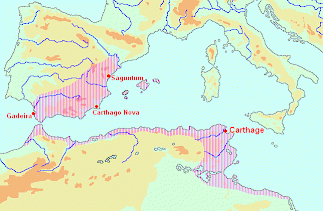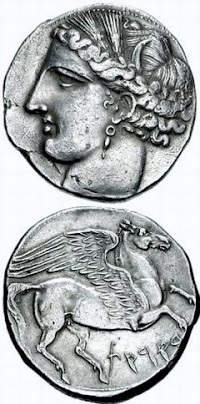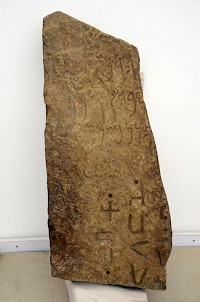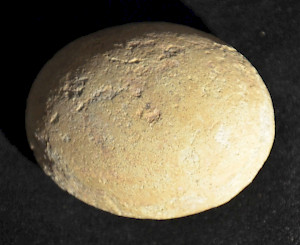Roman Wars
Carthage (Phoenician Kart hadašt, "new city"): important ancient city, close to modern Tunis.
First Punic War

A few years after the defeat of Pyrrhus, the Romans decided to declare war after an incident in Messana. This town had been occupied by former Syracusan mercenaries, called the Mamertines. In 265 BCE, the tyrant of Syracuse, Hiero II, defeated them and laid siege to the city. Immediately, the Mamertines asked help from Carthage, which gladly intervened and sent its admiral Hannibal to defend and occupy Messana. From now on, the Carthaginians controlled the Strait.
However, occupation was not the help the Mamertines had been hoping for. Rome received a call for help too, and decided to intervene, running the risk of full-scale Carthaginian intervention. But Rome could not ignore the request: from Messana, because the Carthaginians threatened the Greek towns of southern Italy's, Rome's new allies. War had become inevitable.

In 264, one of the Roman consuls, Appius Claudius Caudex, invaded Sicily with two legions and captured Messana: the First Punic War had broken out. Next, the Romans laid siege to Acragas and captured this Carthaginian base, which had been defended by the same Hannibal who had garrisoned Messana. However, after these successes, the Roman war machine came to as standstill. The Carthaginians refused to accept Roman control of the Strait, and the Romans understood that they had to conquer the entire island. This meant that they had to gain naval superiority - something that would be very difficult, because the Romans were no sailors.
It was a conflict between an elephant and a whale, which could go on forever. However, the Romans had a secret weapon, called corvus ("crow"). This was a movable bridge with a metal prong that could be dropped onto the deck of a Carthaginian ship. Once the two ships were tied to each other, the naval battle had changed into a land battle. In other words, the Romans used their ships as platforms for fighting. In 260, at Mylae, their consul Gaius Duillius defeated admiral Hannibal, and won Rome's first naval victory ever.
Yet, this victory was not decisive, and the war was to last very, very long. The Carthaginian commander Hamilcar Barca was able to defend the western part of the island, where every Roman success was balanced by either a Carthaginian victory, Roman stupidity, or bad luck (e.g., the loss of a fleet in a storm).
However, the Roman consul Gaius Atilius Regulus, having overcome the Carthaginian navy at Ecnomus, invaded Africa, and although he was defeated by a Greek mercenary leader in Carthaginian service, Xanthippus, it was clear that Rome was the strongest of the two contenders. It had the resources to raise large armies and build new fleets. The final years of the war looked like a stalemate on western Sicily, where Hamilcar Barca fought a guerilla war, but only the Romans was able to recuperate.
In 241, a new Roman fleet, commanded by Gaius Lutatius Catulus, overcame the last Carthaginian ships, commanded by Hanno, near the Aegatian Islands in the far west of Sicily. A peace treaty was signed, and Carthage accepted Roman rule on the island. According to the Greek historian Polybius of Megalopolis, the First Punic War had been "the longest and most severely contested war in history".note
Second Punic War

Compared to this, the Second Punic War, about which we know a lot more, was a comparatively small war. The Carthaginian government accepted Hamilcar's proposal to compensate for the loss of Sicily by conquering Hispania. Here, he built a new empire, which was, after his death, expanded by his son-in-law Hasdrubal the Fair. He was succeeded by Hamilcar's son Hannibal Barca, who provoked a war with Rome in 218, crossed Pyrenees, Rhône, and Alps (text), and arrived in Italy. In several battles (e.g., Trasimene lake, Cannae), he defeated the Romans, but they refused to give up the struggle and cut off Hannibal's supply base in Hispania. At the same time, their commander Marcellus forced Hannibal's army to the south of Italy.
When Hasdrubal Barca, a brother of Hannibal, tried to reinforce the Carthaginian army in Italy, he was defeated; and Publius Cornelius Scipio overcame the last resistance in Hispania. Another Barca brother, Mago, attempted to help his brother, but the Carthaginian government recalled Hannibal once Scipio had invaded Africa. Both sides had Numidian allies: Massinissa supported Rome, Syphax was allied to Carthage. The four armies met in the battle of Zama, where Scipio and Massinissa defeated Hannibal and Syphax (202). This was the end of the second war.
Third Punic War

Yet, even a defeated Carthage remained an important city. It still commanded the trade route from the eastern to the western part of the Mediterranean, and became rich again. It was a valuable addition to the Numidian kingdom of Massinissa. If he would capture the city, Rome would face a new, powerful threat in the southwestern Mediterranean.
Several Roman politicians were afraid and, using the Numidian-Carthaginian War as pretext, decided to start a war. The Third Punic War started in 149 BCE. In 146, the city was destroyed by Publius Cornelius Scipio Aemilianus. Reportedly, he wept when he sacked the ancient city, and displayed more virtue than the last commander of the ancient city, Hasdrubal, who is said to have betrayed the people who trusted him by arranging a private capitulation.